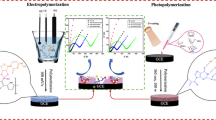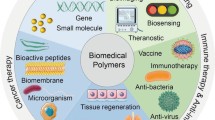Abstract
Imprinted polymers are now being increasingly considered for active biomedical uses such as drug delivery. In this work, the use of molecularly imprinted polymers (MIPs) in designing new drug delivery devices was studied. Imprinted polymers were prepared from methacrylic acid (functional monomer), ethylene glycol dimethacrylate (cross-linker), and bromhexine (as a drug template) using bulk polymerization method. The influence of the template/functional monomer proportion and pH on the achievement of MIPs with pore cavities with a high enough affinity for the drug was investigated. The polymeric devices were further characterized by FT-IR, thermogravimetric analysis, scanning electron microscopy, and binding experiments. The imprinted polymers showed a higher affinity for bromhexine and a slower release rate than the non-imprinted polymers. The controlled release of bromhexine from the prepared imprinted polymers was investigated through in vitro dissolution tests by measuring absorbance at λ max of 310 nm by HPLC-UV. The dissolution media employed were hydrochloric acid at the pH level of 3.0 and phosphate buffers, at pH levels of 6.0 and 8.0, maintained at 37.0 and 25.0 ± 0.5 °C. Results from the analyses showed the ability of MIP polymers to control the release of bromhexine In all cases The imprinted polymers showed a higher affinity for bromhexine and a slower release rate than the non-imprinted polymers. At the pH level of 3.0 and at the temperature of 25 °C, slower release of bromhexine imprinted polymer occurred.








Similar content being viewed by others
References
Mosbach, K. (1994). Trends Biochem Sci, 19, 9.
Komiyama, M., Takeuch, T., Mukawa, T., & Asanuma, H. (2003). Molecular imprinting. Weinheim: Wiley.
Bartsch, R. A., & Maeda, M. (1998). Molecular and ionic recognition with imprinted polymers, ACS Symposium Series 703. Washington, DC: American Chemical Society.
Sellergen, B. (2001). Molecular imprinted polymers. Amsterdam, The Netherlands: Elsevier.
Takeuchi, T., & Haginaka, J. (1999). Separation and sensing based on molecular recognition using molecularly imprinted polymers. J Chromatogr B, 728, 1.
Haupt, K., & Mosbach, K. (2000). Molecularly imprinted polymers and their use in biomimetic sensors. Chem Rev, 100, 2495.
Ho, K. C., Yeh, W. M., Tung, T. S., & Liao, J. Y. (2005). Amperometric detection of morphine based on poly(3, 4-ethylenedioxythiophene) immobilized molecularly imprinted polymer particles prepared by precipitation polymerization. Anal Chim Acta, 542, 90.
Javanbakht, M., Eynollahi Fard, S., Mohammadi, A., Abdouss, M., Ganjali, M. R., Norouzi, P., et al. (2008). Molecularly imprinted polymer based potentiometric sensor for the determination of hydroxyzine in tablets and biological fluids. Anal Chim Acta, 612, 65.
Vallano, P. T., & Remcho, V. T. (2000). Highly selective separations by capillary electrochromatography: molecular imprint polymer sorbents. J Chromatogr A, 887, 125.
Kamal, A., Kumar, B. A., Arifuddin, M., & Dastidar, S. G. (2003). Synthesis of 4β-amido and 4β-sulphonamido analogues of podophyllotoxin as potential antitumour agents. Bioorg Med Chem, 11, 5135.
Puoci, F., Curcio, M., Cirillo, G., Lemma, F., Spizzirri, U. G., & Picci, N. (2008). Molecularly imprinted solid-phase extraction for cholesterol determination in cheese products. Food Chem, 106, 836.
Chen, W., Han, D. K., Ahn, K. D., & Kim, J. M. (2002). Molecularly imprinted polymers having amidine and imidazole functional groups as an enzyme-mimetic catalyst for ester hydrolysis. Macromol Res, 10, 122–126.
Suedee, R., Srichana, T., & Martin, G. (2000). Evaluation of matrices containing molecularly imprinted polymers in the enantioselective-controlled delivery of β-blockers. J Control Release, 66, 135–147.
Sambe, H., Hoshina, K., Moadel, R., Wainer, W., & Haginaka, J. (2006). Uniformly-sized, molecularly imprinted polymers for nicotine by precipitation polymerization. J Chromatogr A, 1134, 88–94.
Allender, C. J., Richardson, C., Woodhouse, B., Heard, C. M., & Brain, K. R. (2000). Pharmaceutical applications for molecularly imprinted polymers. Int J Pharm, 195, 39–43.
Alvarez-Lorenzo, C., & Concheiro, A. (2006). Molecularly imprinted materials as advanced excipients for drug delivery systems. Biotechnol Annu Rev, 12, 225–268.
Hiratani, H., & Alvarez-Lorenzo, C. (2002). Timolol uptake and release by imprinted soft contact lenses made of N,N-diethylacrylamide and methacrylic acid. J Control Release, 83, 223–230.
Alvarez-Lorenzo, C., & Concheiro, A. (2004). Molecularly imprinted polymers for drug delivery. J Chromatogr B, 804, 231–245.
Alvarez-Lorenzo, C., Yanez, F., Barreiro-Iglesias, R., & Concheiro, A. (2006). Imprinted soft contact lenses as norfloxacin delivery systems. J Control Release, 113, 236–244.
Sellergren, B., & Allender, C. J. (2005). Molecularly imprinted polymers: a bridge to advanced drug delivery. Adv Drug Deliv Rev, 57, 1733–1741.
Turchan, M., Jara-Ulloa, P., Bollo, S., Nunez-Vergara, L. J., Squella, J. A., & Alvarez-Lueje, A. (2007). Voltammetric behaviour of bromhexine and its determination in pharmaceuticals. Talanta, 73, 913.
Suedee, R., Srichana, T., & Rattananont, T. (2002). Enantioselective release of controlled delivery granules based on molecularly imprinted polymers. Drug Deliv, 9, 19–30.
Moffat, A. C. (2004). Clarkes analysis of drugs and poisons in pharmaceuticals, Vol. 2 (3rd ed.). London, UK: Pharmaceutical Press.
Guyot, A., Sherrington, D. C., & Hodge, P. (1989). Synthesis and separations using functional polymers (pp. 1–36). New York, NY: Wiley.
Lloyd, L. (1991). Rigid macroporous copolymers as stationary phases in high-performance liquid chromatography. J Chromatogr A, 544, 201.
Spivak, D. A. (2005). Optimization, evaluation, and characterization of molecularly imprinted polymers. Adv Drug Deliv Rev, 57, 1779–1794.
Rachkov, A., & Minoura, N. (2000). Recognition of oxytocin and oxytocin-related peptides in aqueous media using a molecularly imprinted polymer synthesized by the epitope approach. J Chromatogr A, 889, 111.
Panahi, R., Vasheghani-Farahani, E., & Shojaosadati, S. A. (2007). Separation of l-lysine from dilute aqueous solution using molecular imprinting technique. Biochem Eng J, 35, 352–356.
Javanbakht, M., Shaabani, N., & Akbari-Adergani, B. (2009). Novel molecularly imprinted polymers for the selective extraction and determination of metoclopramide in human serum and urine samples using high-performance liquid chromatography. J Chromatogr B, 887, 2537–2544.
Martin, P., Jones, G. R., Stringer, F., & Wilson, I. D. (2003). Comparison of normal and reversed-phase solid phase extraction methods for extraction of b-blockers from plasma using molecularly imprinted polymers. J Anal, 128(128), 345.
Nicholls, I. A. (1997). Combined hydrophobic and electrostatic interaction-based recognition in molecularly imprinted polymers. Recent Res Dev Pure Appl Chem, 1, 133.
Shea, K. J., Spivak, D. A., & Sellergren, B. (1993). Imprinted polymer membranes for the selective transport of targeted neutral molecules. J Am Chem Soc, 115, 3368.
Mullet, W. M., Walles, M., Levsen, K., Borlak, J., & Pawliszyn, J. (2004). Multidimensional on-line sample preparation of verapamil and its metabolites by a molecularly imprinted polymer coupled to liquid chromatography–mass spectrometry. J Chromatogr B, 801, 297.
Acknowledgments
The authors would like to thank Mr. Roghanizad for his technical assistance in experiments.
Author information
Authors and Affiliations
Corresponding author
Rights and permissions
About this article
Cite this article
Azodi-Deilami, S., Abdouss, M. & Javanbakht, M. The Syntheses and Characterization of Molecularly Imprinted Polymers for the Controlled Release of Bromhexine. Appl Biochem Biotechnol 164, 133–147 (2011). https://doi.org/10.1007/s12010-010-9121-y
Received:
Accepted:
Published:
Issue Date:
DOI: https://doi.org/10.1007/s12010-010-9121-y




